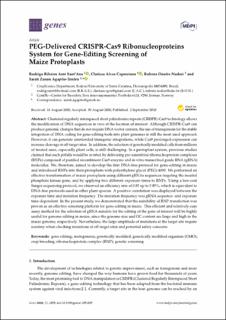| dc.description.abstract | Clustered regularly interspaced short palindromic repeats (CRISPR)-Cas9 technology allows the modification of DNA sequences in vivo at the location of interest. Although CRISPR-Cas9 can produce genomic changes that do not require DNA vector carriers, the use of transgenesis for the stable integration of DNA coding for gene-editing tools into plant genomes is still the most used approach. However, it can generate unintended transgenic integrations, while Cas9 prolonged-expression can increase cleavage at off-target sites. In addition, the selection of genetically modified cells from millions of treated ones, especially plant cells, is still challenging. In a protoplast system, previous studies claimed that such pitfalls would be averted by delivering pre-assembled ribonucleoprotein complexes (RNPs) composed of purified recombinant Cas9 enzyme and in vitro transcribed guide RNA (gRNA) molecules. We, therefore, aimed to develop the first DNA-free protocol for gene-editing in maize and introduced RNPs into their protoplasts with polyethylene glycol (PEG) 4000. We performed an effective transformation of maize protoplasts using different gRNAs sequences targeting the inositol phosphate kinase gene, and by applying two different exposure times to RNPs. Using a low-cost Sanger sequencing protocol, we observed an efficiency rate of 0.85 up to 5.85%, which is equivalent to DNA-free protocols used in other plant species. A positive correlation was displayed between the exposure time and mutation frequency. The mutation frequency was gRNA sequence- and exposure time-dependent. In the present study, we demonstrated that the suitability of RNP transfection was proven as an effective screening platform for gene-editing in maize. This efficient and relatively easy assay method for the selection of gRNA suitable for the editing of the gene of interest will be highly useful for genome editing in maize, since the genome size and GC-content are large and high in the maize genome, respectively. Nevertheless, the large amplitude of mutations at the target site require scrutiny when checking mutations at off-target sites and potential safety concerns. | en_US |

